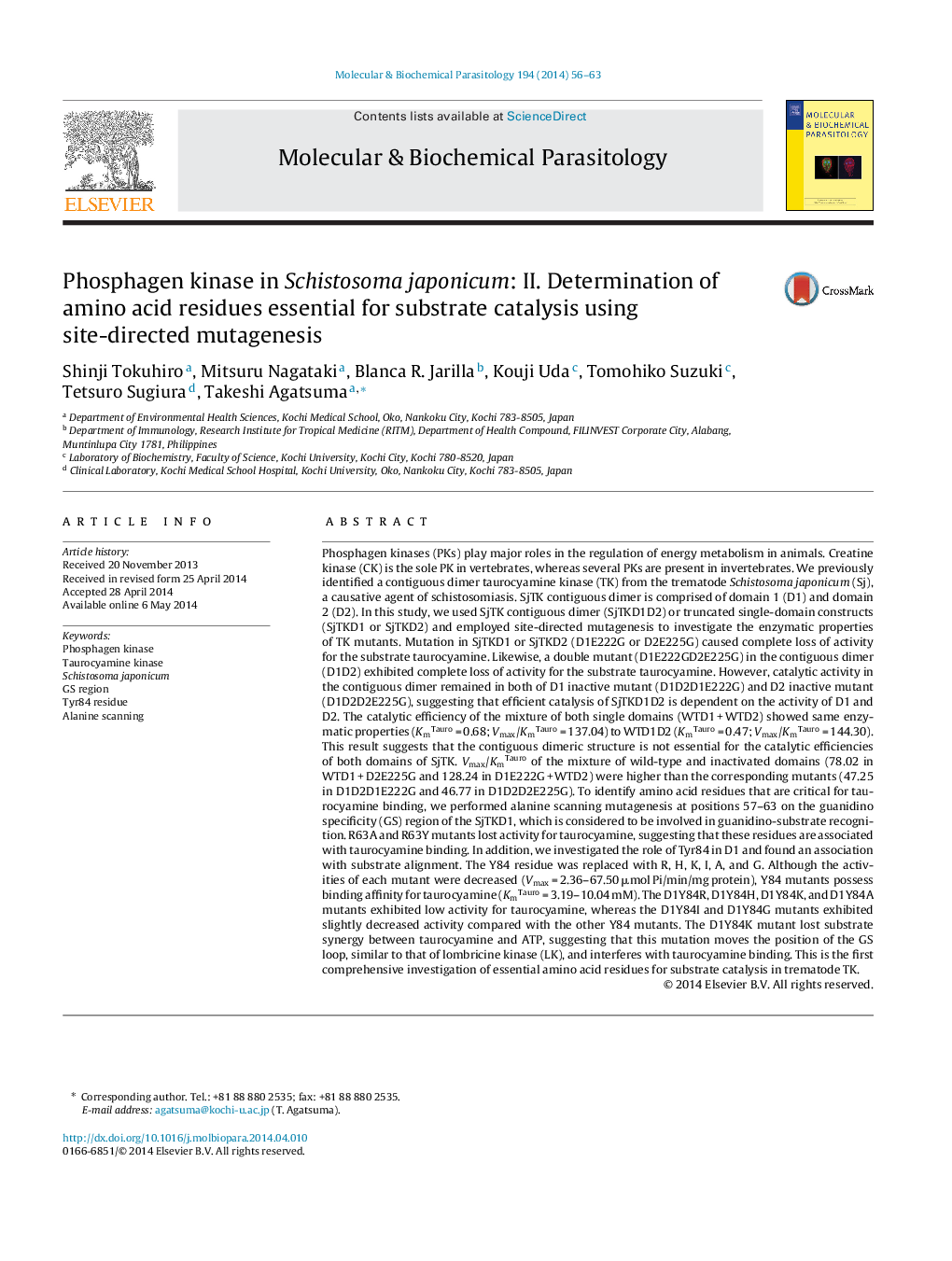| کد مقاله | کد نشریه | سال انتشار | مقاله انگلیسی | نسخه تمام متن |
|---|---|---|---|---|
| 2829786 | 1570651 | 2014 | 8 صفحه PDF | دانلود رایگان |

• Loss of activity by R63 replacement suggests its direct binding to taurocyamine.
• S. japonicum TKD1 Tyr84 replacement decreases enzymatic activity for taurocyamine.
• The Y84K mutant alters GS loop position, impairing taurocyamine binding.
Phosphagen kinases (PKs) play major roles in the regulation of energy metabolism in animals. Creatine kinase (CK) is the sole PK in vertebrates, whereas several PKs are present in invertebrates. We previously identified a contiguous dimer taurocyamine kinase (TK) from the trematode Schistosoma japonicum (Sj), a causative agent of schistosomiasis. SjTK contiguous dimer is comprised of domain 1 (D1) and domain 2 (D2). In this study, we used SjTK contiguous dimer (SjTKD1D2) or truncated single-domain constructs (SjTKD1 or SjTKD2) and employed site-directed mutagenesis to investigate the enzymatic properties of TK mutants. Mutation in SjTKD1 or SjTKD2 (D1E222G or D2E225G) caused complete loss of activity for the substrate taurocyamine. Likewise, a double mutant (D1E222GD2E225G) in the contiguous dimer (D1D2) exhibited complete loss of activity for the substrate taurocyamine. However, catalytic activity in the contiguous dimer remained in both of D1 inactive mutant (D1D2D1E222G) and D2 inactive mutant (D1D2D2E225G), suggesting that efficient catalysis of SjTKD1D2 is dependent on the activity of D1 and D2. The catalytic efficiency of the mixture of both single domains (WTD1 + WTD2) showed same enzymatic properties (KmTauro = 0.68; Vmax/KmTauro = 137.04) to WTD1D2 (KmTauro = 0.47; Vmax/KmTauro = 144.30). This result suggests that the contiguous dimeric structure is not essential for the catalytic efficiencies of both domains of SjTK. Vmax/KmTauro of the mixture of wild-type and inactivated domains (78.02 in WTD1 + D2E225G and 128.24 in D1E222G + WTD2) were higher than the corresponding mutants (47.25 in D1D2D1E222G and 46.77 in D1D2D2E225G). To identify amino acid residues that are critical for taurocyamine binding, we performed alanine scanning mutagenesis at positions 57–63 on the guanidino specificity (GS) region of the SjTKD1, which is considered to be involved in guanidino-substrate recognition. R63A and R63Y mutants lost activity for taurocyamine, suggesting that these residues are associated with taurocyamine binding. In addition, we investigated the role of Tyr84 in D1 and found an association with substrate alignment. The Y84 residue was replaced with R, H, K, I, A, and G. Although the activities of each mutant were decreased (Vmax = 2.36–67.50 μmol Pi/min/mg protein), Y84 mutants possess binding affinity for taurocyamine (KmTauro = 3.19–10.04 mM). The D1Y84R, D1Y84H, D1Y84K, and D1Y84A mutants exhibited low activity for taurocyamine, whereas the D1Y84I and D1Y84G mutants exhibited slightly decreased activity compared with the other Y84 mutants. The D1Y84K mutant lost substrate synergy between taurocyamine and ATP, suggesting that this mutation moves the position of the GS loop, similar to that of lombricine kinase (LK), and interferes with taurocyamine binding. This is the first comprehensive investigation of essential amino acid residues for substrate catalysis in trematode TK.
Figure optionsDownload high-quality image (156 K)Download as PowerPoint slide
Journal: Molecular and Biochemical Parasitology - Volume 194, Issues 1–2, March–April 2014, Pages 56–63